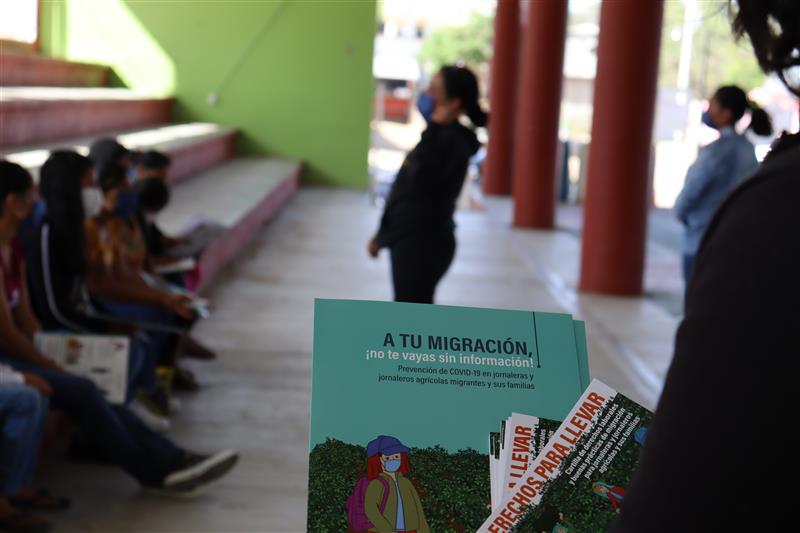Four reasons why labor migration needs a community-based approach

International migrant workers make up nearly 5% of the global labor force, with an estimated 167 million people migrating for employment in 2024. Internal migration is also rising as people move from rural to urban areas through informal channels. Each day, millions of people weigh migration decisions, often with incomplete information and few trusted resources. Whether migrating within one’s country or abroad, there is a decision period when a timely intervention can be life-changing and lifesaving. Economic precarity, climate stress, and manipulative information increasingly shape migration choices, and as border policies become more restrictive, migrants will be pushed towards informal pathways with fewer barriers to entry, reduced oversight, and increased risk.
IREX’s Ambulantes program in Mexico supports nearly 2.3 million internal agricultural migrants who migrate seasonally to work in agriculture throughout the country. In Nepal, IREX’s Navigator program supported community members and migrants contributing to the more than 21 million Nepalis working abroad. Although each program addresses a distinct migration context, both are grounded in IREX's First Mile approach, which prioritizes prevention-focused assistance and community-led solutions.
Through our work, we learned that effective support starts in communities where labor recruitment takes place and key decisions are made—providing assistance that protects workers and empowers communities to advocate for their rights. Below are four of those lessons:
Community-centered research is critical to understanding and addressing migration risks
While macro trends in labor migration are often on national agendas, the impacts of migration on communities of origin are less present in public debate. Community-centered research elevates priorities and provides evidence for program design and advocacy around key issues that influence community members’ decisions to migrate. These often include access to education for children, effects of substance abuse in the workplace, and the costs and benefits of different migration routes as compared to local livelihoods. Community-centered research also surfaces exploitation that communities have normalized, from forced labor conditions and organized crime at agricultural sites in Mexico to prolific recruitment scams in Nepal. This research also confirms systemic issues with enforcement of labor rights and fair working conditions, barriers to justice, and difficulties accessing health and support services for migrant populations that face barriers and challenges.
Practical information is key to informed migrant decision making
Partners and community members have shown IREX that delivering actionable information to migrant communities starts with understanding how people communicate and whom they trust. Multilingual content through community radio and libraries, visual tools for non-literate audiences, participation in local community events, and community-led training create lasting dialogue on safe migration. Community feedback underscores impact beyond information sharing: workers detect fraudulent recruitment earlier, families feel better prepared to support relatives, previously normalized violations are surfaced, and communities have greater access to legal and other support services. We also learned that gaps in digital and financial skills, mental health support for returnees, and links to job-training, which when addressed in collaboration with community members, enables local partners to build community knowledge that persists after projects end.
Building local capacity is essential to sustaining safe migration networks
Sustained impact comes from investing in trusted partners who remain in communities. In Mexico, supporting leaders of indigenous organizations with clear information on migrant destinations and risks enables them to raise issues in community assemblies, initiating safeguards like requiring recruiters to disclose identities and destinations of workers. In Nepal, government decentralization has placed safe migration responsibilities at the local level, necessitating training for community engagement, law enforcement, and judicial actors on the relationship between migration, trafficking, and forced labor. Building this local capacity connects people to active support networks—including lawyers and paralegals—and helps migrants navigate a complex recruiting and employment ecosystem. These capacities, when paired with knowledge of viable livelihood, training opportunities, and local employment alternatives, provide a counterweight to overwhelming migration push factors which lead to uninformed decisions.
Highlighting community voices drives migrant-centered policy change
Community-generated evidence is essential for migrant-centered policy. Strategic advocacy based on learning from migrant communities of origin can transform policy by supporting ethical journalism, building consensus with local leaders, and convening government, community, and business stakeholders. Because communities routinely identify gaps between law and practice, reforms must address both policy design and implementation, prioritizing transparent labor inspections, minimum-wage enforcement, pay fairness, formalized contracts and social benefits, and accessible health and education for migrant families. Additionally, public perception often undervalues the importance and skills of migrant labor, even with internal migrants that share the same nationality. This is why it is important to underpin policy advocacy with public awareness campaigns that elevate the value of migrant labor and the systemic challenges their communities face.
Looking ahead
As migration pressures intensify, the practitioners should prioritize sustained investment in origin communities, strengthening institutions and networks that transform how people approach migration and worker protection. The First Mile approach offers a practical, adaptable framework for scale: start with community priorities; invest in trusted intermediaries; deliver information through existing channels; and use community evidence to drive policy change. Supporting migrants begins with supporting the places where migration decisions are made, so that people have agency, migrate more safely, and communities see long-term returns from labor migration programs.